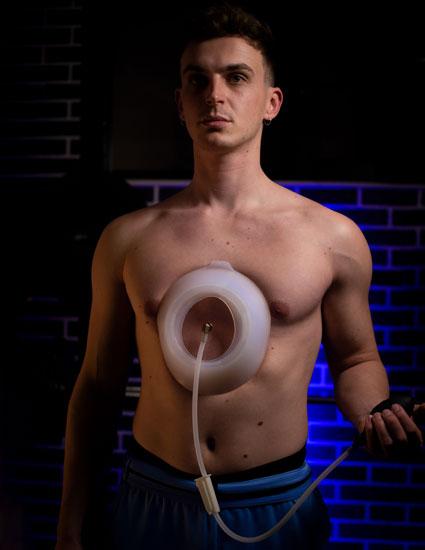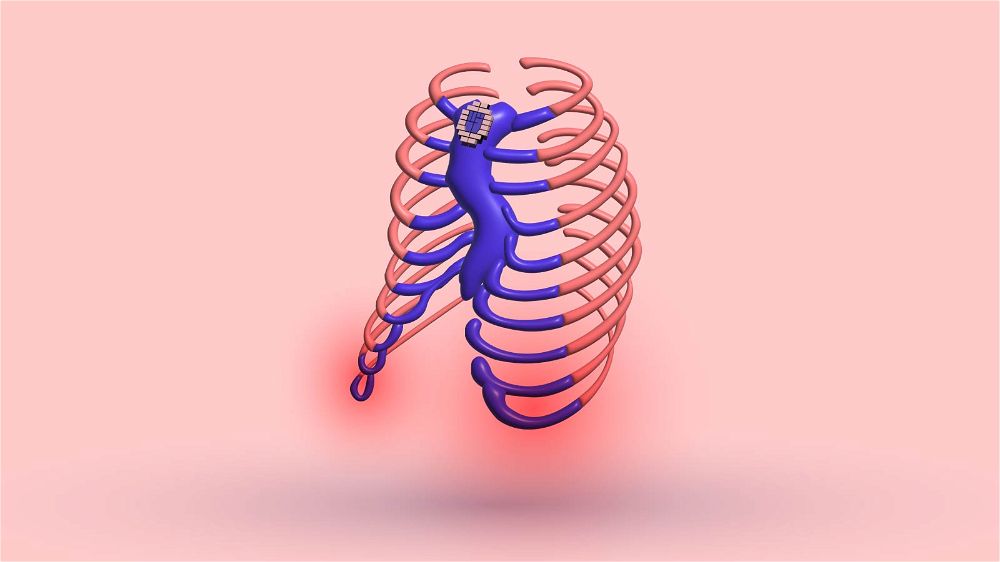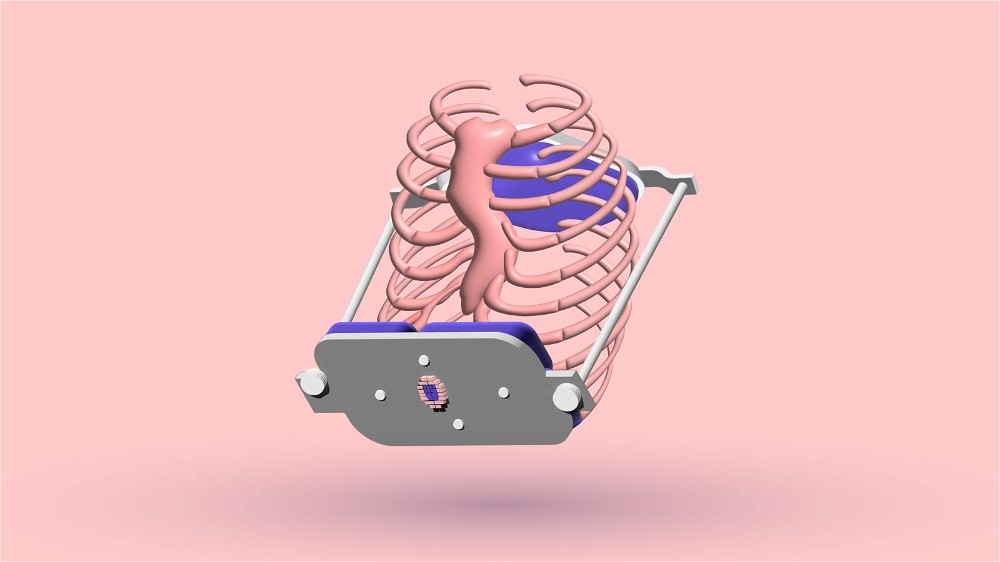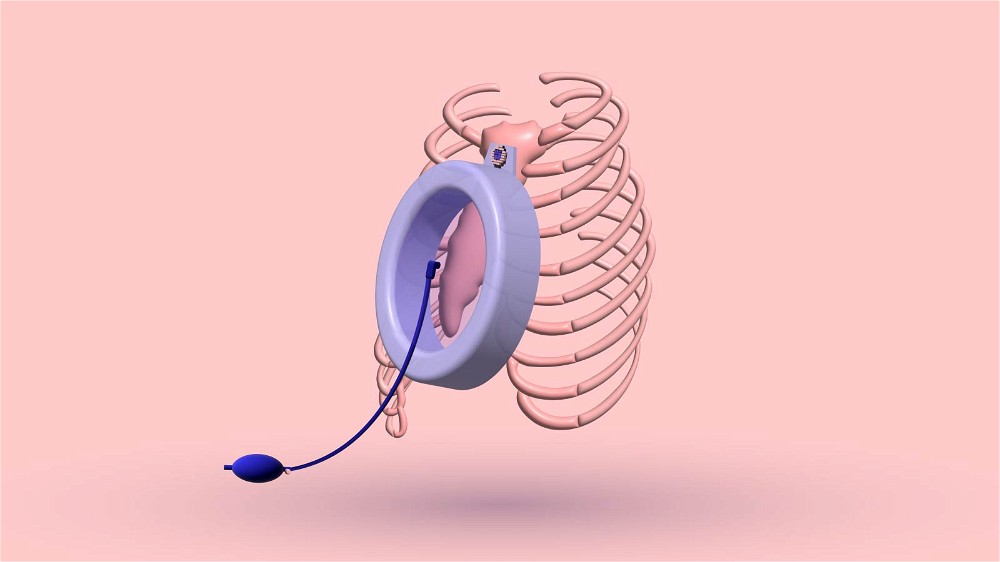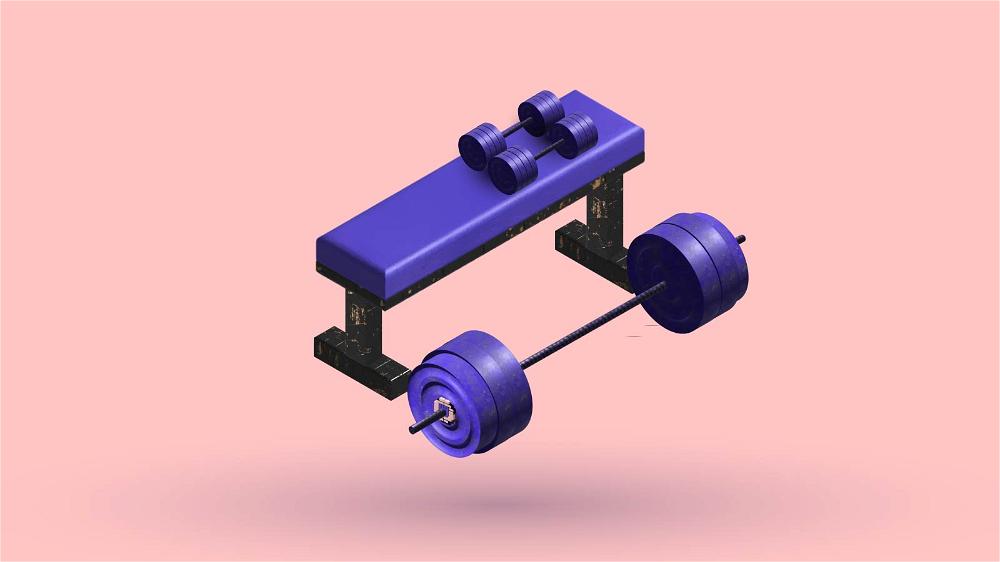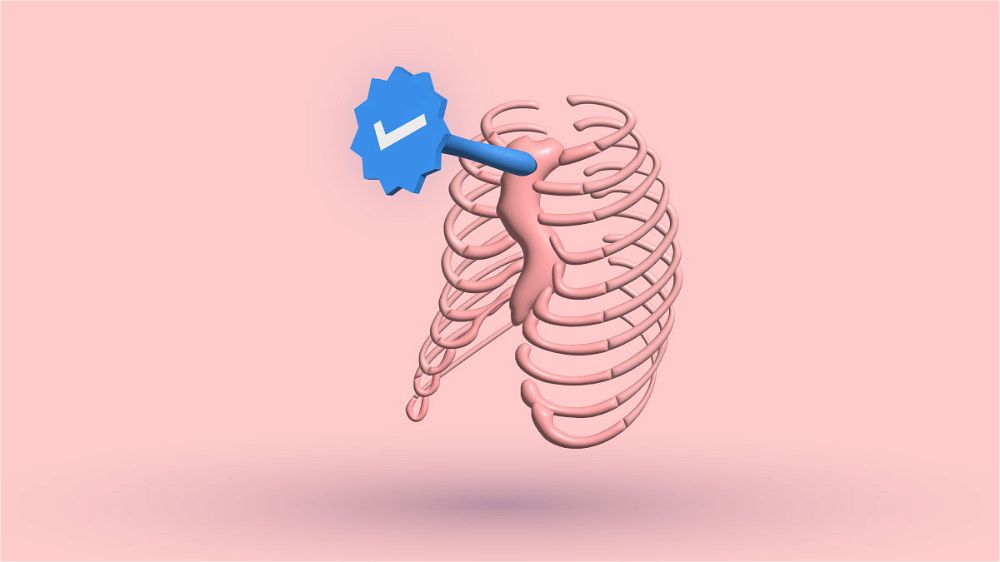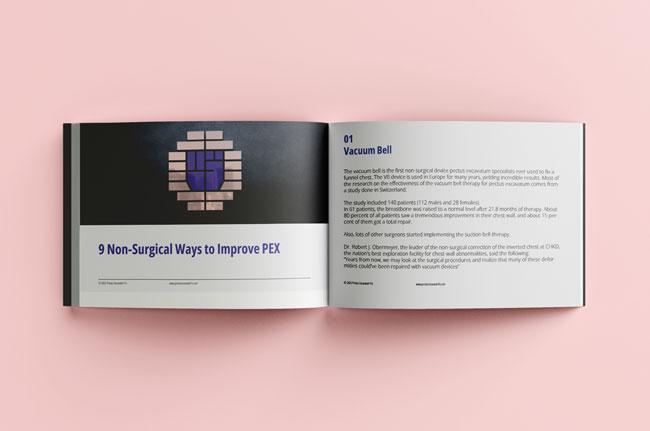If the pectus excavatum deformity is severe, it can cause physical pressure on the heart. The heart cannot expand like it is meant to, as in a normally shaped chest.
It can have reduced space and be turned to the breast's left side. Because of this, the heart operates under restrained conditions. Each heartbeat carries less blood to the other parts of the body.
You'll typically feel a rapid heartbeat while the body is physically struggling. This is when increased blood volume (cardiac output) is needed.
THE HEART OF A PE PATIENT DOESN'T PUMP ENOUGH BLOOD

The amount of blood needed depends on the patient's body size and shape. During sternal physical activity, over 10 liters of blood in a minute may be required.
The compressed heart of the pectus excavatum sufferer has to beat more aggressively to provide the same amount of blood as in a healthy person. Contrarily, a healthy person's heart can expand more and pump out more blood with each heartbeat.
The concave chest patients have high pulse frequencies. They also feel their "heart racing" and have limited stamina during sports.
This is most evident while doing long-distance running or swimming. Young people can tolerate a rapid heart rate easier than older sufferers.
WHAT DID A RESPECTED PECTUS SURGEON SAY?

When we measure our pectus excavatum patients before the surgery, they often have a heartbeat of 200 or more, even after a small physical activity. This an unnaturally high heart rate.
Klaus Schaarschmidt
Klaus Schaarschmidt said this in a 2012 article written in German. He is the primary physician at the children's operational clinic at Helios Hospital Berlin, Germany.
He adds,
If left untreated, the life expectancy of funnel chest sufferers is nearly ten years lower.
Additionally, about ten percent of the patients will develop a problem with the heart valves. These are crushed and compressed by the indentation. This causes them to leak. Dr. Klaus also mentions that a kid even required a heart valve replacement at 16.
PECTUS EXCAVATUM CAN CAUSE CARDIAC ARREST & DEATH

Patients that suffer from a severe case of pectus excavatum are prone to critical heart problems compared to milder cases. There is a scientific case of a 28-year-old man who suffered from a severely hollowed sternum and had two heart attacks in eight months.
After miraculously surviving the cardiac failures, doctors did Electrocardiographic investigations on him. The studies showed auricular fibrillation and recorded pause in the precordial passage, showing heart rotation.
In addition to the rotation, the angiocardiogram showed heart displacement. The cardiac catheterization revealed a cardiac performance one-half as high as the expected standard.
This means the patient's heart worked at 50% of its capabilities. On top of that, the displacement restricted blood flow. Doctors concluded that a severe pectus excavatum deformity could cause cardiac arrest and even death.
HEART MURMUR CAUSED BY PECTUS EXCAVATUM

Consider a 2013 study led by cardiologist Shuji Hashimoto. They concluded pectus excavatum is a cause of heart murmur.
Researchers examined a 33-year-old man with a moderate severity of pectus excavatum during the study. The heart murmur caused by his sunken sternum was audible while standing and sitting.
However, the doctor's diagnosis concluded that the intensity of his heart murmurs increased with postural change.
This happened because his irregular anterior chest wall pushed the pulmonary artery when standing. Now that we resolved that pectus excavatum is linked to heart murmurs, read the following to get more familiar with it and whether this condition is harmful to your health.
IS HEART MURMUR DANGEROUS?
Even though a heart murmur doesn't require therapy, you must visit a doctor to ensure the pectus excavatum deformity doesn't cause a severe heart problem. Heart murmurs are swishing or wheezing noises that occur during your heartbeat cycle.
It is caused by uncontrolled blood in or around your heart. It is the most frequent irregular heart sound. If you have this, a health care provider can hear it through a stethoscope. Heart murmurs are commonly genetic (you are born with them).
However, they can grow later in your life, especially if you suffer from the pectus excavatum deformity. A heart murmur isn't a disease or a disorder. But, it can indicate an underlying heart issue you may not be aware of.
10 SYMPTOMS OF HEART MURMUR
Generally, you may have a heart murmur, but you aren't aware of it. You can check the following symptoms, as stated by Mayo Clinic, to help you detect whether you suffer from it.
- Suffering from a pectus excavatum deformity
- Bluish skin discoloration, particularly on the fingers and lips
- Heart and chest ache
- Lightheadedness or fainting, especially during a physical activity
- Expansion of the neck veins and liver
- Unreasonable sweating irrelevant to warmth or exercise
- Unwillingness to eat an abnormal growth in infants and children
- Breathing difficulties through physical effort
- Swelling in the toes, legs, or stomach
- An abnormal increase in weight
THREE SCIENTIFIC CASES OF PECTUS EXCAVATUM AND CARDIAC TAMPONADE
FIRST CASE
A 2017 Korean study, supported by Yeungnam University, reveals how a 23-year-old female patient that underwent the Nuss procedure to correct her pectus excavatum needed an emergency treatment with clinical signs of cardiac tamponade.
The syndrome occurred 16 and 18 months after a successful Nuss procedure. The study concluded that the Nuss procedure could lead to life-threatening conditions like cardiac tamponade.
The surgery can manifest as early or delayed complications, such as in this case. The doctors healed the 23-year-old successfully with a mixed therapy of oral anti-inflammatory medications and surgical drainage.
To keep yourself healthy post-surgically, you must always follow up in the outpatient clinic.
SECOND CASE
Researchers investigated the second case of pectus excavatum linked with cardiac tamponade in a 2004 UK study by M. J. Barakat and J. A. Morgan. A 24-year-old guy required immediate emergency surgery because of clinical signs of cardiac tamponade.
It was caused by a sternal wire from a pectus excavatum surgical repair two years earlier. It has cracked and pierced through the pericardium, leading to epicardial damage and haemopericardium.
THIRD CASE
The third case of a late complication after a funnel chest surgery happened to a 12-year-old kid. It happened two years after a successful surgical repair. A hemopericardium and tamponade occurred because a fractured metal plate in the pericardium penetrated the right atrium.
Researchers studied this case in a 1991 Italian study led by Elami A. and Lieberman Y. All these scientific articles point out that life-threatening complications like tamponade may occur, even years after a successful pectus excavatum surgery.
WHAT IS CARDIAC TAMPONADE?

Cardiac tamponade is a disorder caused by increased fluid in the pericardial area (the pouch around the heart). After the fluid builds up, it decreases ventricular filling and hemodynamic compromise.
In other words, it leads to heart compression. In addition to fluid, the heart can also accumulate blood clots, pus, gas, and blood.
The occurrence of this syndrome requires a medical emergency. The complications involve pneumonic edema, shock, and even death.
4 INDICATORS OF CARDIAC TAMPONADE
Symptoms are usually the same as those in cardiogenic shock. If you feel any of the following signs of cardiac tamponade, seek immediate medical treatment.
- Shortness of breathing
- Physical and mental tiredness
- Feeling that you may faint
- Nagging cough
A 2003 study by David H. Spodick medically approves these symptoms.
ENLARGED HEART & CONCAVE CHEST SCIENTIFIC PROOF

A 1973 scientific research proves that the pectus excavatum deformity can cause an enlarged heart. A 21-year-old male with a concave chest was evaluated for cardiomegaly (enlarged heart).
He had a very rapid heartbeat and had no other indication of a heart disorder. His physical medical test was healthy, except that he had a mild dent in his chest. The study proved that the pectus excavatum deformity caused an enlarged heart in this patient.
An enlarged heart can enhance the danger of heart failure. In that case, the heart muscle weakens and isn't capable of pumping enough blood to the rest of your body.
Also, it can cause blood clots. If they access the bloodstream, they can hinder blood flow to essential organs, leading to stroke or cardiac arrest, which can be fatal.
CARDIAC ARRHYTHMIA AND PECTUS EXCAVATUM

Pectus excavatum is closely related to cardiac arrhythmia (irregular heartbeat). There is a bright piece of scientific proof that confirms this.
The study examines how a 24-year-old lady was brought to the emergency room with a rush of heart palpitations. Upon testing, the female patient was discovered to have the pectus excavatum condition.
The deformity causes the breastbone to compress the right ventricular wall, leading to a reduced proper ventricular ejection fraction. When you combine this with right atrial enlargement and pulmonary hypertension, the patient will probably suffer from cardiac arrhythmia.
In addition to the first study, a recent 2017 research reported a 14-year-old kid with severe pectus excavatum diagnosed with cardiac arrhythmia. His irregular heartbeat lasted for around 15 minutes on average.
Other than the sunken chest, the kid was perfectly healthy. He had no other cardiovascular symptoms, and his medical records were excellent. Doctors decided to repair his indented chest deformity with a minimally invasive Nuss procedure.
After correcting the deformity, heart arrhythmia was also solved. This directs to a direct relationship between pectus excavatum and cardiac arrhythmia.
FAST HEART RATE & PECTUS EXCAVATUM

A study done in 2009 revealed a close connection between pectus excavatum and rapid heart rate, especially after exercise. In the study, an older person who was physically active complained of a racing heart and trouble breathing after doing physical activity.
The doctors tested him on an electrocardiogram, which revealed 220 heartbeats a minute. This is very high, especially after resting long after doing the exercises.
After that, doctors did health checks on the 59-year-old gentleman. Surprisingly, doctors found no underlying illness. The sufferer's rapid heartbeat even worsened, and it motivated him to do a web search, which pointed out that the pectus excavatum was the leading cause of his heart problems.
After consulting a thoracic surgeon, he underwent a Ravitch Procedure that repaired his deformity. Shortly after the surgery, the patient was free of shortness of breath and a fast heart rate. The 59-year-old man could freely continue to do important physical exercises three months after surgery.
The study figured out that if you suffer from pectus excavatum, you commonly experience a racing heartbeat and overall fatigue after exercise. Repairing the deformity will also lead to the correction of your heart problems.
CONCLUSION
The pectus excavatum deformity is more harmful to your health than you’ve previously thought. It can directly affect its functioning. The heart is probably the most crucial organ in your body that is always required to perform optimally.
If you suffer from an inverted chest deformity, please see a cardiologist or a thoracic surgeon that has experience dealing with it. Even if you don’t feel symptoms, an underlying heart problem may require immediate treatment.
19 Sources
- Winkens R, Guldemond F, Hoppener P, Kragten H, van Leeuwen Y. Pectus excavatum, not always as harmless as it seems. BMJ Case Rep. 2009 Dec
14;2009:bcr10.2009.2329. - Parks CM, Manohar M. Distribution of blood flow during moderate and strenuous exercise in ponies (Equus caballus). Am J Vet Res. 1983 Oct;44(10):1861–6.
- Gesundheit: Krater im Körper. Der Tagesspiegel Online [Internet]. [cited 2022
Dec 2]; Available from: https://www.tagesspiegel.de/gesundheit/krater-imkorper-2049055.html - Helios Kliniken, Berlin-Buch, Pectus Hospital in Berlin, Germany [Internet]. [cited
2022 Dec 2]. Available from: https://www.pectus.com/hosp/helios-kliniken-berlin-buch - Ravitch MM. Pectus excavatum and heart failure. Surgery. 1951 Jul 1;30(1):178–
94. - Nakasone I, Hashimoto S, Masuda Y, Nakatani S. Increased heart murmur with
standing in a case of pectus excavatum. J Echocardiogr. 2013 Sep;11(3):121–2. - Shuji HASHIMOTO | National Cerebral and Cardiovascular Center, Osaka |
NCVC | Department of Clinical Physiology [Internet]. [cited 2022 Dec 2]. Available from: https://www.researchgate.net/profile/Shuji-Hashimoto - health enews | A news service from Advocate Aurora Health [Internet]. [cited
2022 Dec 2]. Available from: https://www.ahchealthenews.com/ - Heart murmurs - Symptoms and causes [Internet]. Mayo Clinic. [cited 2022 Dec
2]. Available from: https://www.mayoclinic.org/diseases-conditions/heart-murmurs/symptoms-causes/syc-20373171 - Baek JH, Lee YU, Jung TE, Lee DH, Lee JC. Late cardiac tamponade following
Nuss procedure for pectus excavatum. J Thorac Dis. 2017 May;9(5):E424–6.
953 - Cardiac Tamponade: Practice Essentials, Background, Pathophysiology. 2021
Oct 17 [cited 2022 Dec 2]; Available from: https://emedicine.medscape.com/article/152083-overview - Barakat MJ, Morgan JA. Haemopericardium causing cardiac tamponade: a
late complication of pectus excavatum repair. Heart. 2004 Apr;90(4):e22. - Pericardium - Wikipedia [Internet]. [cited 2022 Dec 2]. Available from:
https://en.wikipedia.org/wiki/Pericardium - Spodick DH. Acute cardiac tamponade. N Engl J Med. 2003 Aug
14;349(7):684–90. - Hunt KK, Cole R. Roentgenogram of the month. Cardiomegaly and pectus excavatum. Chest. 1973 Oct;64(4):511–2.
- Enlarged heart - Symptoms and causes [Internet]. Mayo Clinic. [cited 2022
Dec 2]. Available from: https://www.mayoclinic.org/diseases-conditions/enlarged-heart/symptoms-causes/syc-20355436 - Li T, Bishop-Rimmer E, Shieh M, Kreiger P, Felberbaum M, Heller M. Pectus
excavatum: a cause of serious cardiac dysfunction and dysrhythmia. Am J
Emerg Med. 2015 Sep;33(9):1333.e1-2. - Ejection Fraction: What It Is, Types and Normal Range [Internet]. Cleveland
Clinic. [cited 2022 Dec 2]. Available from: https://my.clevelandclinic.org/health/articles/16950-ejection-fraction - Ventricular arrhythmia solved by surgical correction of pectus excavatum |
Interactive CardioVascular and Thoracic Surgery | Oxford Academic [Internet].
[cited 2022 Dec 2]. Available from: https://academic.oup.com/icvts/article/26/4/706/4735132




